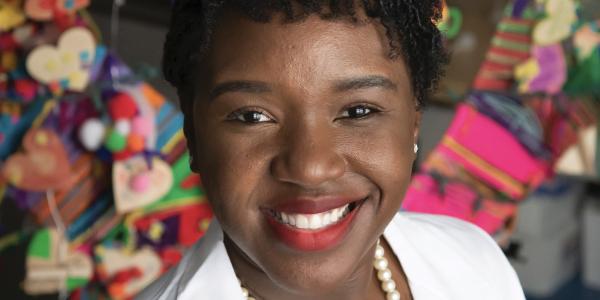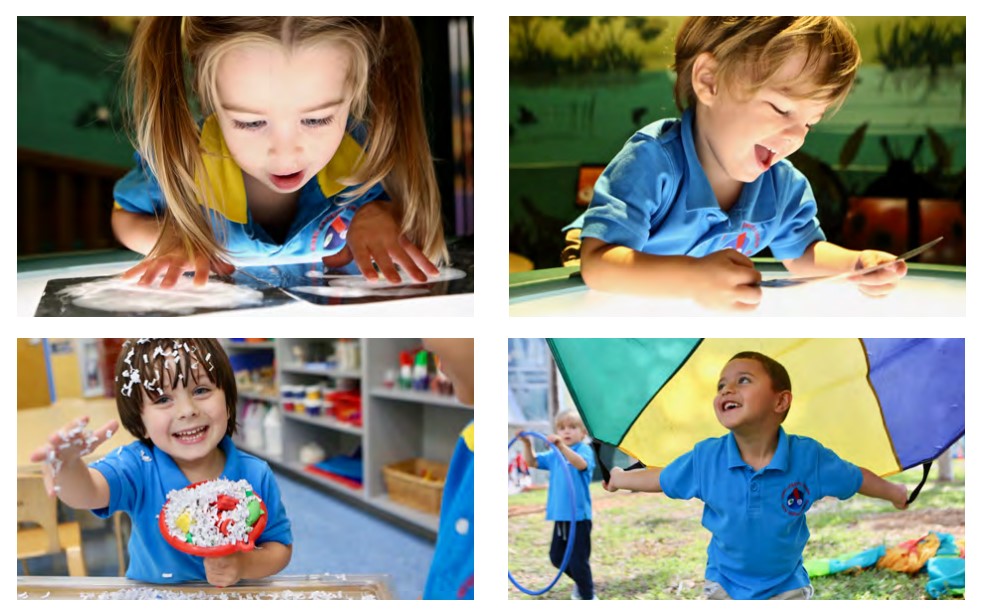Member Spotlight: Natalie Williams

You are here
One of NAEYC’s key tenets is to ensure that each and every child is reflected in their early learning settings and feels a sense of belonging there. It’s a mission that is embodied by Natalie Williams, this issue’s Member Spotlight. Natalie’s roles with the NAEYC-accredited Miami Children’s Museum Preschool and NAEYC’s Affiliate Advisory Group put her on the frontlines of this important work. As she says, “Education and representation are key contributors to a more equitable world.”
Michelle Kang, Chief Executive Officer
Natalie Williams
Director of Education, Miami Children’s Museum Preschool, Miami, Florida
A passion for equity and inclusion has informed Natalie Williams’ 20-year career in the early childhood profession. She has served and advocated for children, families, and early childhood educators in for-profit, not-for-profit, and alternative settings, always with an eye toward reaching those who might feel othered or marginalized because of who they are. “I’m known as the voice of the underdog. What do children need? What do teachers need? I see teens and adults whose childhood trauma is still affecting their joy, and it reminds me how important the early childhood space is.”
Natalie began her career with Jumpstart, an AmeriCorps program that partners with college students, community organizations, preschools, and school districts to prepare children in under-resourced communities for kindergarten. She has led early learning programs at Bright Horizons in both Florida and New York and at a variety of centers around the Sunshine State. Today, she is the director of education for the NAEYC-accredited Miami Children’s Museum Preschool, where she tends 90 children. As part of her work, she also liaises with the museum’s charter school (310 children representing 41 cultures) and manages four after-school programs that serve 345 children in three Miami-Dade neighborhoods.
Natalie is currently overseeing a national research project at the museum’s preschool and working on a proposal for the Institute of Museum and Library Services. She serves on NAEYC’s Affiliate Advisory Group. Following are excerpts from a recent conversation.

You earned a degree in childhood development from Florida State University. What drew you to the early childhood field?
I knew that I loved children. I began in child development because I wanted to understand the brain. I knew the first five years were important, but I wanted to better understand why.
You never wanted to be a classroom teacher, though.
I always saw the bigger picture. I knew I wanted to make an impact in the entire field rather than one classroom. I had a professor who said, “You could be the director of a preschool.”
And here you are. You’ve directed centers across Florida, and you’ve headed the Miami Children’s Museum Preschool for the past two years. What drew you to this venue?
I wanted to come back to Miami because Miami is home, and you reach a point in your life where you want to be part of the change you envision for your hometown. I definitely wanted a new experience in education, and I didn’t want it in a typical learning environment. Museum education is a state-of-the-art approach to caring and educating young children. The exposure to art, culture, galleries, community—it’s truly one of a kind. We prepare children for lifelong learning, including promoting critical thinking, communication, collaboration, creativity, and other essential skills. I am not a traditional person or educator, and we don’t take a traditional approach to school readiness. Nothing is more rewarding than transforming children into scholars of the future.
You’re in the midst of a research project funded by the Institute of Museum and Library Services (IMLS). What are you hoping to discover?
We know museum-based preschools are different, but is the difference good, and why? What are the benefits of the visual arts and learning? We’ve never scaled that against non-museum-based programs, which this study will do. We’ll do baseline research at Miami Children’s Museum, then partner with three to five museums around the US. If you change the curriculum and change the players and change the communities, are you going to get the same results? IMLS has given us almost $203,000. That will fund us for three years, but we believe the study will last five to seven years because we intend to follow children into kindergarten and through third grade. It’s exciting to be able to find measurements of what we’re doing.
Inclusion is a theme that runs through everything you do. What does it look like in your particular setting?
Enrolling in our school means your child may be in a classroom with children from different cultures or children with different physical and cognitive abilities or children with different gender identities. I had a family call recently who was concerned about a boy in one of our classes who has two moms and who was playing with dolls. They went from, “I don’t want my daughter around a boy who plays with dolls” to “Thank you for educating us and helping us understand how to better support our daughter.”
That’s a pretty big jump. How did you navigate it?
We have the space to hear and talk through the family’s perspective. I never say, “Your views are wrong.” I try to validate those views, then help them see alternatives. NAEYC helps. I rely on articles and the “Developmentally Appropriate Practice” position statement. Advancing Equity & Embracing Diversity in Early Childhood Education has been particularly helpful.
Education and representation are key contributors to a more equitable world: I want you to see that I’m a Black woman. I want you to see my dreads. I want you to see that I’m queer. The LGBTQIA+ community needs a seat at the table, but more importantly, they need to be able to eat at the table. That means my voice matters, and my views and the views of the communities I serve are important. Diversity, equity, and inclusion are shown through practices, policies, and approaches to learning. When we’re treated as equal contributors, that’s when we’re heading in the right direction to an equitable tomorrow.
How did you come to join NAEYC?
Several years ago, I was the field director for a program, and I was struggling with aspects of quality. I did some research and found Bright Horizons. From my perspective, that organization was the leader in quality care. Its preschools were doing early childhood education very well, and it was a big NAEYC supporter. I joined Bright Horizons in 2010 as a director of schools and curriculum trainer. I had joined NAEYC as a student member in college, but that was the year I became a paying member.
How has NAEYC membership impacted you?
Most of my true learning about early childhood education came from NAEYC. I attend conferences and read the position statements and publications. I check in with the HELLO forum. NAEYC is always with the times. It’s never afraid or ashamed to stand on the side of what’s equitable, and that’s my kind of people.
Early in my career, I had a situation in which a child regularly engaged in biting. I didn’t know what to do with this challenging behavior at the time: when a child is biting in a class of 10 other children, where families are paying top dollar, no one wants to hear that it’s developmentally appropriate. They want resolution, and they want it right away. I didn’t know how to access those resources or how to support that child and every other child in the class. Thankfully, that’s where NAEYC comes in. The level of education and resources provided to us in the field as a NAEYC-accredited program truly supports high quality. Giving directors the support and education they need is key to ensuring our entire community has access to this quality—whether the child is enrolled in a public school-based pre-K program, a private preschool, a home-based preschool, a community school, Early Head Start, a faith-based preschool, or a museum. We all can thrive in the field as long as we all have access to resources, education, and support.
You recently joined NAEYC’s Affiliate Advisory Group. Why was that important to you?
Early childhood education looks different in every state. As a change agent, I understand that policies and true change occur when we are informing our policymakers of what’s happening in our communities. The Affiliate Advisory Group gives me the platform to inform our leaders in the field and advise them as best I can of what our teachers, children, and families need.
What’s ahead for you?
I’d like to invest in early childhood education around the world. I’m a strong advocate for Black and Brown children.
SHARE YOUR STORY Answer a few questions to tell us about your work with young children and what NAEYC membership means to you.
NOMINATE A MEMBER Share why a NAEYC member you know should be recognized for their work with young children.
Photographs: courtesy of Natalie Williams
Copyright © 2023 by the National Association for the Education of Young Children. See Permissions and Reprints online at NAEYC.org/resources/permissions